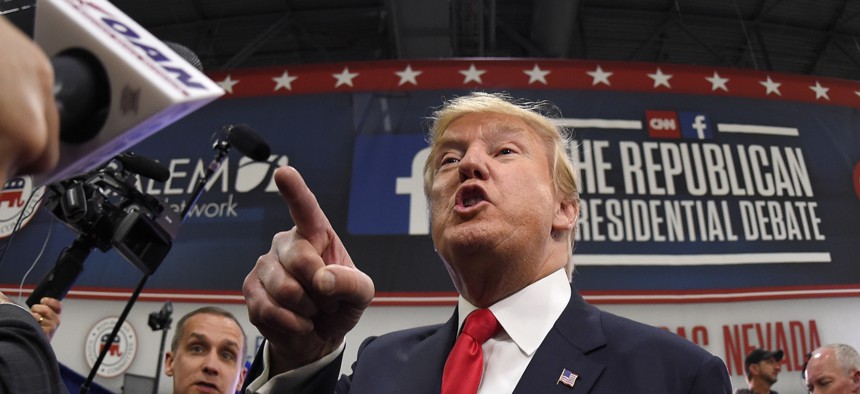
Donald Trump talks to the press in the spin room following the CNN Republican presidential debate at the Venetian Hotel & Casino on Tuesday, Dec. 15, 2015, in Las Vegas. AP Photo/Mark J. Terrill
Here’s What Each 2016 Candidate Has Said About Using Military Force
The Presidential Candidates Use of Force Tracker aims to capture and better understand the sort of military missions that prospective presidents might pursue.
Presidential campaigns are largely consequence-free environments unburdened by the pressures and responsibilities that come with actually sitting in the White House. A candidate can say or pledge to do anything no matter how troubling, costly, or unlikely. The one policy recommendation that every presidential candidate has strongly endorsed during this election cycle—with differing degrees of scope and intensity— is the use of military power. With the sixteen-month war against the self-declared Islamic State stalemated and the percentage of Americans naming “national security and terrorism” the top federal government priority having nearly doubled since April, appeals to force have played an unusually significant role this presidential campaign. This is unsurprising, since military force remains the most responsive, fungible, and destructive foreign-policy tool that a candidate can propose. Unfortunately, the military options put forth may sound tough, but they are rarely articulated in a concrete and actionable manner, which makes it difficult to evaluate the wisdom of the proposals.
To capture and better understand the sort of military missions that prospective presidents might pursue once in office, we are publishing the Presidential Candidates Use of Force Tracker. The information relies upon each active candidate’s campaign webpage, interviews, public speeches, and participation in the presidential debates. The candidates appear alphabetically, with each listing containing the military options they proposed, the relevant country or threat, the stated political and/or military objectives, and whether it would be conducted unilaterally or multilaterally. We use direct quotes to assure that the proposed option is not taken out of context, and so readers can judge for themselves the candidates’ seriousness. We include only kinetic uses of force, not shows of force, such as Governor Chris Christie’s pledge to personally fly Air Force One over disputed islands in the South China Sea.
The Tracker will be updated over the next year as candidates propose new military options, clarify or state new political and military objectives, and, in some cases, switch their policy recommendations entirely. View the Presidential Candidates Use of Force Tracker below (it requires scrolling to the right), or as a Google spreadsheet.
This post appears courtesy of CFR.org.
NEXT STORY: Tough Talk vs. Military Muscle



